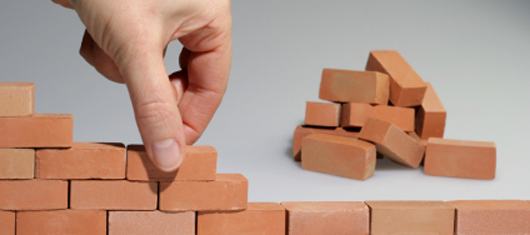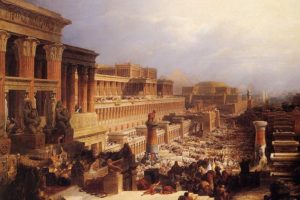In a previous blog post on Haggai, I discussed one of the expectations the people of Israel held concerning Yahweh’s (the personal name of God) powerful action on their behalf, an expectation that included their current state of economic affairs.
Upon the obedience of his command to rebuild the Temple, they expected to participate, once again, in the covenant blessings and all the economic abundance these promised blessings entailed. This expectation, coupled with the expectation that God would manifest his presence upon their completion of the rebuilding project, served to set the stage for something different. Rather than taking part in a vivid and tangible experience of the presence of God, the people of Israel would need to align their own expectations with God’s present relational activity.
Previous to Haggai’s time, Yahweh had manifested his presence in a powerful way. One of the most potent times this happened in Israel’s history was at the dedication of Solomon’s temple. At this point in time (circa. 950 BC), the people of God were a single kingdom, ruled by a king named Solomon. Solomon himself was the son of, probably, the most famous monarch in Jewish history, King David. After many hard fought battles to unite the kingdom and establish its borders, David was tasked by Yahweh to gather supplies and create the context for which his son, Solomon would build the Temple. And build it he did! It was a marvelous piece of architecture with every aspect of decoration specially designed to point an individual to the recognition and worship of Yahweh. The entire structure, interior and exterior, was a testament to his graceful presence dwelling in their midst. In fact, 1 Kings 8 tells how this aspect of his divine presence became, quite literally, overwhelmingly clear.
After bringing the ark of the covenant, into the newly constructed Holy of Holies (the innermost room in the Temple), Yahweh’s divine presence so filled the area (shrouded by a thick and impenetrable cloud) that “the priests could not stand to minister because of the cloud, for the glory of Yahweh filled the house of Yahweh” (1 Kings 8:11). In recognition of the people’s obedience to his command to prepare a place in the center of their midst dedicated to his worship, Yahweh acted. In an extravagant display of his grace, he revealed his own manifest presence (also known as the Shekinah glory) in the Temple. This powerful experience of his divine presence was a declaration by Yahweh that he dwelt among his people in a very tangible way and, in addition, that the people of Israel were under his divine protection. Importantly, as we continue with our study of Haggai, this event also confirmed that Yahweh had kept and would continue to keep his promises, especially those associated with the continuance of the Davidic throne (2 Sam. 7).
During Yahweh’s powerful manifestation in Solomon’s Temple, at the moment the priests were forced (due to the thick and impenetrable cloud) to stop their sacrifices and stand with the people in awe of his divine presence, Solomon publicly addressed Yahweh in front of the people of Israel. In this address, he recognized that, although Yahweh’s presence now dwelt among the people in the Temple, to understand this structure as containing the almighty God of the Universe was a gross oversimplification and misinterpretation of this event they were privileged to observe. The Temple itself (the house of Yahweh) would serve as a vivid illustration of his active work among his people. It was important, claimed Solomon, that the people understood and recognize this blessing by offering prayer and worship in his name only (1 Kings 8:27-30). Yahweh would be their God and Israel would be his people. Their very identity would be found in him as they participated in the covenant blessings (economic, political, and spiritual) he offered as he dwelt in his sacred space.
In Haggai’s day, the people of Israel, having returned from exile, are now working to rebuild what was once lost, to restore the house of God. And, upon the completion of their building project, they were expecting Yahweh to show up, manifesting his presence and providing them with an experience like that of the people of Solomon’s day. Except, this does not happen. Ezra 6:15 tells that the temple was completed around March 12, 515 BC (the sixth year of Darius’ reign), a little over 70 years after was destroyed. It took four years to complete (the construction started in September 520 BC) and its completion was marked with a special ceremony dedication. It was a joyous occasion involving lots of sacrifices and installation of priests who would lead the continued worship of Yahweh. However, the ceremony was markedly different from the dedication of the original temple in 1 Kings 8, a difference, as we shall see in the next installment of this blog, alluded to in the 2nd chapter of the book of Haggai.





Leave a Reply
Your email is safe with us.